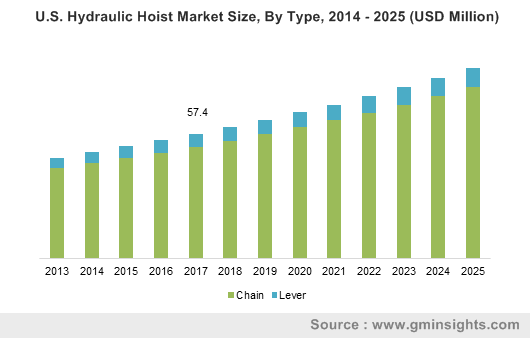An application-oriented outline of Hydraulic Hoist Market: APAC to emerge as a viable growth avenue over 2018-2025, driven by robust industrialization trends
Publisher : Fractovia | Published Date : June 2018Request Sample
The extensive growth graph of hydraulic hoist market can be aptly demonstrated by the recent accrual of the Finland based hoist manufacturer, Scanclimber, by the Tractel Group which manufactures, sells and services suspended access solutions, lifting and handling devices and load measurement equipment worldwide. Through the deal both Tractel and Scanclimber are attempting to strengthen their position in the hydraulic hoist industry. While Tractel will use Scanclimber’s presence in Norther Europe to expand its business in this region, Scanclimber will benefit from increased sales in regions like North America and Singapore.
U.S. Hydraulic Hoist Market Size, By Type, 2014 – 2025 (USD Million)

Hoists, having found extensive applications across a slew of industry domains, have led to hydraulic hoist market becoming one of the most matured business spheres in recent times. These pivotal products are largely used in areas that involve heavy lifting such as the automotive, construction, mining, chemical, retail, and pharmaceutical sectors. Given the expansion of most of the aforementioned verticals across the Asian belt, it is rather overt that Asia Pacific will emerge to be one of the most lucrative growth avenues for the market. With the expansion of manufacturing and production capabilities, most Asia Pacific based industries are aiming at greater automation of processes which has become one of the driving forces for exploration, innovation and development in the hydraulic hoist industry. Advancement in hydraulic hoist technology has been augmented by customers in this region demanding upgradation in controls, sensor and software as well as precising positioning methodology.
Another trend that has been observed among the growing industries is the demand for online monitoring of heavy lifting equipment that has in turn caused the hydraulic hoist industry to invest more in research and development programs to come up with online hoist status monitoring and preventive maintenance inputs. For instance, MHE-Demag, developers of cranes and hoists, developed the Demag StatusControl which is a wireless remote access system that analyses and evaluates data in real time. An intuitive software tool can be used to remotely monitor the system. Through the system customers can schedule maintenance work with increased precision and avoid any possible downtime.
While customers in tight labor markets like Singapore have been raising the demand for smart features that can help in creating a full-fledged automated warehouse, countries like India and Bangladesh, where heavy processes like streel automobile, power etc. have a commendable presence, have raised the demand for safety. Both these demands have helped in shaping the hydraulic hoist market that has come up with tailor made products to suit each industry. For example, Konecranes, one of the hydraulic hoist industry leaders has come up with a wire rope hoist that is suitable for any industry involving the lifting of up to 80 tons. Konecranes also provides manual products, including hand-held chain blocks up to 20t capacity. Such manual products have registered popularity and have improved work ergonomics across certain regions in APAC where electricity is unavailable.
Other than industrial uses, hydraulic hoist market share has witnessed an increase from other sectors such as entertainment and healthcare. The demand for hoists in the hospitality industry for instance, has been particularly appreciable in the EU where legislation for manual handling practices has been laid down to ensure safer workplaces. As a result, the lifting equipment demand has been compounded in pubs, bars and restaurants so much so, that architects have started to make provisions for lifting equipment in their building designs.
Ranging from outdoor concerts to sporting events, most entertainment companies have increased their usage of hoists. Naturally, most customers show a strong preference for equipment that is reliable, easy to use, low cost and needs minimal maintenance, driving the demand for chain hoists. Incidentally, chain hoists accounted for 90% of the hydraulic hoist market size in 2017 and are expected to garner quite some acclaim in the ensuing years.
Complemented by the increased construction projects in countries such as China and India and the surge in mining activities in Japan, hydraulic hoist market trends are likely to undergo a major transformation in the years to come. Despite the possibility that industry outlook may be somewhat deterred by the expansion of the electric hoist industry, the easy operability and reliability of the product will assist the vertical retain profitable returns over 2018-2025.